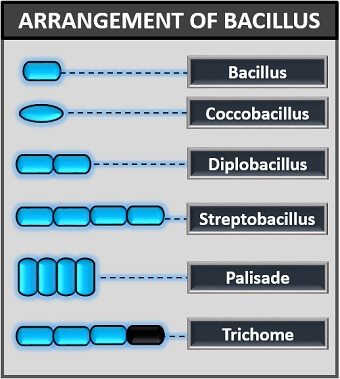Bacterial shape and arrangement vary from species to species. Bacteria exist in many forms, but the most common types are bacilli, cocci and spirilla. Some bacteria are pleomorphic, i.e. they live in variable shapes. Bacteria are prokaryotic cells as they have a primitive nucleus, i.e. bacteria devoid of a nucleus and a nuclear membrane that surrounds the genetic material.
Bacteria are the unicellular structures, i.e. they are minute enough, that we could not see them through the naked eye. Through culturing and isolation of bacteria, you can examine the bacterial shape and arrangement by methods of staining and microscopy.
Through microscopic observation, we can determine the morphological or physiological characteristics of bacteria based on bacterial shape and arrangement. In this lesson, we will discuss the size range, common shapes and different arrangement of bacteria.
Content: Bacterial Shape and Arrangement
Size of Bacteria
The bacterial size ranges from 0.5-1.0 µm, which you can observe in the highlighted portion of the image below. The spherical shaped bacteria have an average diameter ranging from 0.5-2.0 µm, whereas the rod shaped bacteria have an average diameter of 0.25-1.0 µm. Some bacteria possess a diameter of 80 µm and a length of 600 µm, which we can see through the naked eyes. For example, Epulosiscium fishelsoni.

In the most diverse group of bacteria, mycoplasma is a type of bacteria considered as the smallest organism (measures a size of 0.25 µm). The largest bacteria known so far is Thiomargarita namibiensis, which measures a size of 0.1-0.75 nm. Being a prokaryotic cell, the size of bacteria is smaller than the eukaryotic cells like fungi.
Because of bacteria’s small size, their structure becomes more complicated. Even though of small size, bacteria can communicate with the other microorganisms through a mechanism called “Quorum sensing”. Bacteria can also function as a multicellular population rather than an individual organism.
Shape of Bacteria
The rigid cell wall decides the shape of bacteria. Generally, there are three common shapes of bacteria, namely, cocci, bacilli and spirilla.

Cocci
It is a plural form, which represents a large number of bacteria possessing a spherical shape. Conversely, coccus is a singular form, which represents a single spherical-shaped bacterial cell. Cocci are small, round and slightly flattened in shape. They can appear singly or in pairs, chains, groups, clusters etc.
Examples: Staphylococcus aureus, Streptococcus hominis, Neisseria gonorrhoea etc.
Bacilli
It is a plural form, which represents a bacterial population possessing a rod shape. Oppositely, coccus is a singular form representing a single rod-shaped bacterial cell. Bacilli are small, cylindrical and elongated in appearance. They can appear either singly or in pairs, groups etc.
Examples: Lactobacillus sp, Salmonella sp, Escherichia coli etc.
Spirilla
It is a plural form, which represents a large number of bacteria that possess a helical shape. whereas spirillum is a singular form that represents a single helical-shaped bacterial cell. Spirilla are small, curved and coiled in appearance. They usually appear singly.
Examples: Treponema pallidum, Spirillum minus, Chlamydia trachomatis etc.
Other forms of Bacteria

- Pleomorphic Bacteria: This group of bacteria do not possess a characteristic shape and size and they exist in variable shapes throughout their life cycle. Examples: Mycoplasma pneumoniae, Deinococcus radiodurans, Mycoplasma genitalium etc.
- Filamentous Bacteria: Some bacteria are filamentous in structure by having a long and tubular shape. The filamentous bacteria are sometimes branched, resembling the filamentous structure of fungi, i.e. mycelium. Examples: Candidatus savagella, Nocardia amarae, Alcaligenes paemba, Thiothrix sp. etc.
- Star-shaped Bacteria: Stella is a type of bacteria, which resembles a star.
- Box-shaped Bacteria: They are square-shaped bacteria having flat or straight edges. Box-shaped bacteria appear as a thin, flexible sheet with a smooth surface. Small cells are square-shaped, and large cells are rectangular. Box-shaped bacteria adhere to each other after cell division. In 1980, box-shaped bacteria were isolated from the natural salt ponds. Examples: Haloarcula vallismortis, Haloarcula marismortui etc.
- Appendaged Bacteria: This group of bacteria possess an extension or outgrowth in the form of stalk, hypha or buds.
- Sheathed Bacteria: These appear like a rod shape or filamentous structure and they mostly found in the aquatic habitat and sludge. Example: Lepiothrix sp etc.
Video
Bacterial Arrangement
The arrangement of bacteria defines the position and organisation of bacteria that strongly depends upon the type of cell division. The bacteria are grouped into four types based on bacterial cell arrangement and cell number.
Arrangement of Cocci
The arrangement of cocci is more complicated than the bacilli. Cocci cells can remain attached after the cell division. In cocci, cell division can occur in many ways like in one plane, two planes, three planes or randomly. They exist in various forms based on the arrangement and cell number:

- Diplococci: These cells appear in pairs, and the cell division occurs in one plane.
Examples: Neisseria gonorrhoea, Diplococcus pneumoniae etc. - Streptococci: They form a chain by adhering to each other. Cell multiplication occurs in one plane.
Examples: Streptococcus pyogenes, Streptococcus mutans, Streptococcus mitis etc. - Tetracocci: These cells form a group of four cells and remain joined with each other. In tetracocci, cell division occurs in two planes.
Example: Gaffkya tetragena etc. - Sarcinae: These cells appear as a group where the cell division occurs in three planes but in a regular pattern.
Examples: Sarcina aurantiaca, Sarcina lutea, Sarcina ventriculi etc. - Staphylococcus: These cells appear as a grape-like cluster where the cell division occurs in three planes with an irregular pattern.
Examples: Staphylococcus aureus, Staphylococcus epidermis, Staphylococcus auricularis etc.
Arrangement of Bacilli
The bacillus cells remain attached after the cell division. In bacilli, cell division occurs in one plane. They exist in various forms based on the arrangement and cell number:

- Coccobacilli: They are oval and rod-shaped bacteria, where the division occurs in one plane.
Examples: Acinetobacter lwofii, Brucella canis etc. - Diplobacilli: They appear and exist in pairs after the cell division. In diplobacilli, cell division occurs in only one plane.
Examples: Coxiella burnetii, Moraxella bovis etc. - Streptobacilli: They have a rod shape and exist in the form of a long chain. In streptobacilli, cell division occurs in one plane.
Example: Streptobacillus moniliformis etc. - Palisades: These are rod-shaped bacteria arranged in a side by side sequence, which closely resembles the matchsticks.
Example: Corynebacterium diphtheria - Trichomes: These are rod-shaped bacteria, which exist in the form of a chain and resemble the string of streptobacilli. In contrast to streptobacilli, trichomes have a much larger area of contact between the adjacent cells.
Examples: Spirulina sp, Oscillotoria sp etc.
Arrangement of Spirilla
The spirillum cells have a rigid spiral structure and they usually exist singly. In the spiral bacterial cells, twisting occurs within the cell, which eventually gives it a helical shape. They are of two types, based on arrangement and number:

- Vibrio: They appear comma-shaped and form after one complete twist.
Examples: Vibrio cholera, Vibrio vulnificus etc. - Spirochetes: It is another type, which forms after two or three complete twists. Spirochetes are highly flexible in structure.
Examples: Spirochaeta sp , Treponema sp , Borrelia sp etc.
Conclusion
We can conclude that bacteria are tiny creatures that exist in various sizes, shapes and organization depending upon the organism’s type, growth pattern, cell division and many other factors. The size, shape and arrangement of the bacteria can be studied using different microscopy and staining methods.